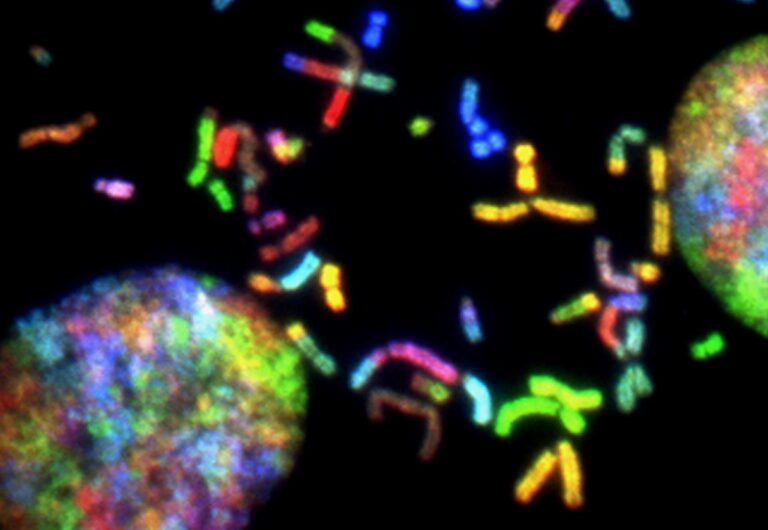Every cell in the body contains 23 pairs of chromosomes. During meiosis, the cell division process that creates sperm and eggs, matching chromosome pairs swap chunks of DNA with each other. This increases genetic diversity.
The resulting cells, known as egg and sperm cells, are haploid. They each contain a single set of chromosomes.
What is a chromosome?
Chromosomes are long chains of DNA (deoxyribonucleic acid) packaged together with proteins into dense, thread-like structures that are visible only under a microscope. Each chromosome contains many genes (hundreds to thousands) organized into a specific sequence. These genes provide instructions for building cells and creating an organism’s physical characteristics.
Each cell in your body has 23 pairs of chromosomes (46 total chromosomes). Your eye-ball cells, for example, have a different set of chromosomes than the liver cells in your stomach. This is because each cell must carry out a different function. When a cell divides, each new cell gets half of the chromosomes from its parent. This process of genetic transfer is called meiosis.
In most species, males and females have identical sets of chromosomes. Egg and sperm cells, however, contain one complete set each of chromosomes from their parents. This means that, when sperm and eggs fuse to form a fertilized embryo, the embryo has 46 chromosomes — 23 from the father and 23 from the mother.
A chromosome is a long strand of DNA that is tightly coiled and super coiled many times around proteins that support it. The DNA in a chromosome is colored using dyes that are attached to the proteins. The ends of a chromosome are attached to each other at a spot called the centromere. The centromere is a region that contains repeated sequences of DNA and also has special protein binding sites that help maintain the integrity of chromosomes during cell division.
What are sex chromosomes?
In human beings, the genetic material that determines biological sex is contained in two specific chromosomes: the X and Y chromosomes. In combination, they determine whether an individual is male or female. These chromosomes are not organized in homologous pairs like the other 44 autosomal chromosomes, which are also responsible for the traits that make us who we are.
When sperm cells fuse with an egg cell that has 23 chromosomes, they create a diploid cell of 46 chromosomes called a zygote. The zygote contains the sex chromosomes, which are still separated into X and Y halves.
During meiosis, the separate X and Y halves pass one copy of each to each haploid daughter cell. The sex chromosomes determine which daughter cells become female and which become male. Then during fertilization, the sex chromosomes determine the sex of the offspring.
Sex chromosomes are a bit more complex than the other chromosomes in that they don’t always come together in homologous pairs, and they contain genes that aren’t related to an individual’s biological sex. However, despite their unique role in determining sex, the sex chromosomes have led to a lot of confusion about gender identity and the way that we think about the differences between men and women. That’s partly because X and Y aren’t the only chromosomes that determine sex; in fact, there are many other genes as well.
What are haploid cells?
A haploid cell is a cell that contains only one complete set of chromosomes. Haploid cells are found only in egg and sperm cells, which are also known as gametes. Egg and sperm cells are produced by the process of meiosis. During meiosis, diploid cells divide to produce two haploid daughter cells. Each haploid daughter cell receives half of the original sets of chromosomes from its parents. During this process, the pairs of homologous chromosomes line up and exchange pieces in a process called crossing over. This process reduces the number of chromosomes and creates genetic variation in the resulting haploid cells.
As a result of meiosis, egg and sperm cells have only 23 chromosomes each. This is half the number of chromosomes that are present in diploid somatic cells in the human body. The sex chromosome pair that determines whether a child is a boy or a girl (XY chromosomes) is unique to egg and sperm cells.
Once haploid egg and sperm cells fuse at the time of fertilization, they form a zygote, which has 46 chromosomes. The zygote has 23 chromosomes from the egg and 23 chromosomes from the sperm. The fusion of these two cells is what determines gender in humans. Haploid cell division is important because it reduces the risk of miscarriages, birth defects and developmental disorders.
What are zygotes?
When one egg cell and one sperm cell combine in a process called fertilization, they create a single-cell embryonic zygote. The zygote contains 23 pairs of chromosomes—half from the mother and half from the father. It also has a large number of mitochondria, which provide energy for cells.
The chromosomes from the mother and sperm cell pair up in a process known as meiosis, a type of cell division that reduces the number of chromosomes. The chromosomes then fuse together through a process called fusion. This allows the chromosomes from each parent to mix with those from the other parent, creating new genes with slightly different sequences. This is a key part of the process that leads to genetic diversity in humans and other animals.
Each zygote contains the genetic information to become an adult with its own set of traits. The zygote also contains basic patterns of methylation and histone acetylation, which direct its early development.
Zygotes develop inside the body of animals that have internal fertilization, such as mammals and birds. Reptiles, on the other hand, encase their zygotes in protective membranes known as zonae pellucidae. Once the zygote enters the female’s fallopian tube, it can be fertilized by sperm cells released during sexual intercourse or assisted reproductive technology procedures like intrauterine insemination and in vitro fertilization.
See Also:






